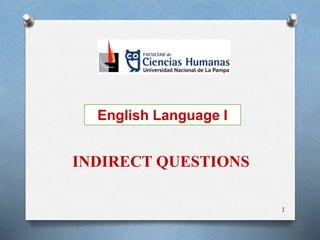
Indirect questions
- 1. 1 English Language I INDIRECT QUESTIONS
- 2. INDIRECT QUESTIONS O Indirect questions are needed for a formal or semi- formal style. We use them when we want to be more polite, more formal or less confrontational. O In making indirect questions, some grammatical changes occur. How far in advance do I need to book? I would like to know how far in advance I need to book. 2
- 3. Have a look at this conversation: Me: Excuse me. Could you tell me where the nearest station is? Passerby: Certainly. It's along that road on the right. Me: Thank you. And do you know if there's a supermarket near here? Passerby : Yes, there's one next to the station. Me: Thank you very much for your help. 3
- 4. Useful beginnings: O Could you tell me which / when / whether … O I would appreciate it if you could … O I would be grateful if you could … O I am interested in finding out … O I would like to know if … O Do you know when … O I wonder if I might … O Could you possibly tell us if … 4
- 5. Are these sentences correct? If not, rewrite correctly. O I wonder if you could tell me how much is the food. O Could you let me know where is the new Indian restaurant? O Do you know how long the food will take to cook? O I would like to know when will you bring fresh vegetable. O Can you tell me what flavour are the crisps? 5
- 6. Rewrite as indirect questions: O Which bands will be performing? O Is there a discount for students? O Will the equipment be provided? O What other facilities are available? O How much will it cost? O When do the adventure holidays take place? O Which sports are offered? O Could you give me more information? O Can you send me a catalogue every month? O What advice can you give me as regards food and drink? 6
- 7. Theoretical aspects: Where is the bank? // Could you tell me where the bank is? In the indirect question I put the verb ('is') after the subject ('the bank'), as I do with a normal positive sentence. But in the direct question, I put the verb ('is‘) before the subject. This is called inversion, and it is used to make direct questions in many verb tenses in English. However, we don't use inversion in indirect questions. The grammar in indirect questions is very similar to the grammar of reported questions. Indirect questions are very common in English, especially when you're talking to someone you don't know. 7
- 8. Theoretical aspects: 'Yes / No' Questions To make an indirect 'yes / no' question, we use 'if' and the word order of a normal positive sentence. This is the same as for reported 'yes / no' questions. On the other hand, we don't usually need to 'backshift' (change the tense of the verb) as we do with reported questions. Most tenses make questions by using 'inversion' (changing the word order). To change from a direct 'yes / no' question with inversion to an indirect question, you add 'if' or ‘whether’ and change the word order back to a normal positive sentence. You don't need to use inversion. 8
- 9. Theoretical aspects: Using 'do‘ When there is no auxiliary verb (be, have, can, will, etc.) in a sentence, we need to put in do, does or did when we create a direct question. When we make this into an indirect question however, we don't use the verb 'do'. For example: Direct: When does the lesson end? Indirect: Could you tell me when the lesson ends? 9